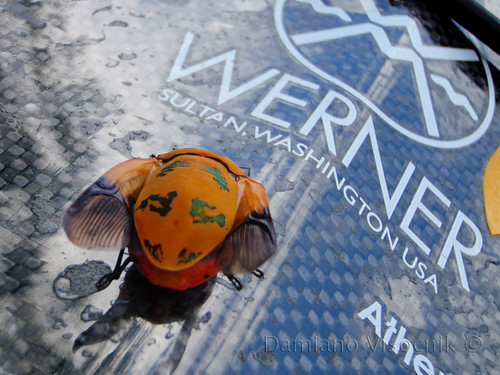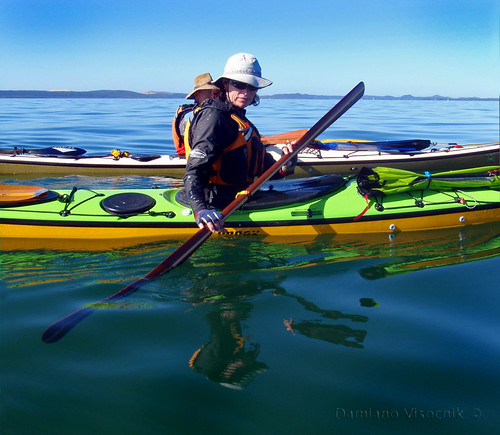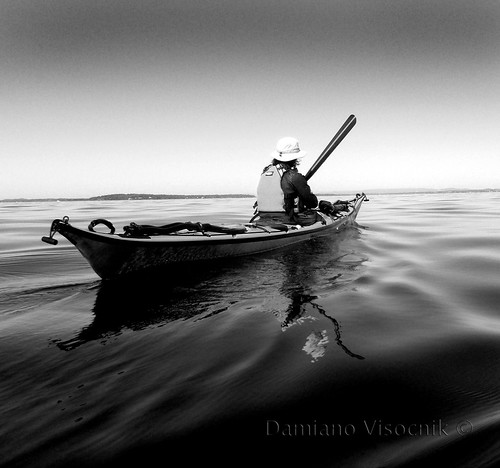I have been looking at traditional type paddles with suspicion.
I’m not one for nostalgia.
I don’t like antique furniture or vintage cars.
Old houses are not my thing and I see little value in old artifacts.
Call me shallow but I like new things, often shiny :-).
Therefore all the talk about Greenland paddles being something that has been around for thousands of years was not winning me over.
However I kept on seeing very skilled paddlers using those sticks.
It kind of annoyed me; surely they were just “mucking around”
Then I read that some very long trips have been done recently with a Greenland style paddle.
Namely the circumnavigation of Iceland in 2007 in 33 days.
Freya Hoffmeister paddled with a wing style paddle and Greg Stamer with a GP.
Since the two paddled together they must have paddled at the same speed.
I think that it’s understood that Freya ain’t no slouch therefore Greg must have kept up OK with his paddle.
It got me thinking… hmmm.
Somehow I wanted to try and find out if it was hype or fact, this stick business.
Unfortunately there were no traditional paddles to try.
Nobody in my area that I knew had one.
There was a short (storm) GP that a friend of mine carved himself but seeing him having to slide that thing between his hands while paddling somehow put me off.
My idea of paddling was: grip that carbon paddle of mine with white knuckles and push hard.
That’s how real man paddle (or so I thought)
A few months later my paddling buddy Vanilla (don’t let the name fool you: nothing vanilla about him but his kayak’s color) produced a laminated Aleut paddle.
Admittedly it was beautiful to look at.
So smooth, such rich wooden colors and so pretty (see, shiny again).
Paddling with it was disappointing to me: too heavy.
His stick was double the weight of my carbon Werner!
After a few hours my shoulders were killing me. I was used to my 750 gr. Carbon Werner paddle.

Recently I have been offered a Greenland paddle by Elverpaddles .
Tom needs some nice pictures of his paddle in action and he made me one to use on my trips.
His paddle is laminated with a thin spine of Oregon (Douglas Fir, for added strength…how does he know that I can be a bit rough with my stuff?) while the rest is Western Red Cedar.
At 900 grams It feels well balanced since most of the weight is at the loom (centre) and very little weight at the ends (swung weight).
Elverpaddles can be as light as 650 grams, depending on construction.
He personally delivered the paddle and instructed me briefly on how to use it.
The stroke with a GP is a little bit different than with a Euro paddle.
It seems that a lower angle and more relaxed stroke are favored by GP paddlers.
The paddle also requires a slightly different catch technique.
Tom told me that I will know when I would have perfected my GP stroke: my paddling will be silent.
So armed with my new shiny stick I committed to not use the Werner for a whole weekend of paddling.
Conditions were varied.
I used the Elverpaddles Tour while paddling a British style kayak (not that it was essential) and part of the trip was while under sail.
.jpg)
At first the paddle felt a bit odd.
If I muscled too strongly the paddle would flutter. I had to ease into it.
I remembered Tom telling me to angle the blade slightly when entering the water.
Nice smooth easy strokes.
Sure it was easy, actually too easy.
I was not putting much effort while paddling and obviously I was not going anywhere fast.
Or was I?
My partner Tess was using a mid sized Euro paddle right next to me (Werner Shuna) and surprisingly we were cruising at the same speed.
How can that be? I felt like I was not putting in much effort and still moving at my cruising speed.
Even sprinting felt OK. My kayak would go just as fast as when paddled with my Cyprus.
One thing I did notice is acceleration. From standing still I would briefly fall behind in a rushed get away.
Bringing my kayak to speed required a couple more strokes.
I have not tried to surf yet with the GP but Tom assures me that can be done if willing to alter the technique a bit *
Tess used the GP on the second day of the trip. She kept her Shuna on the deck.

While initially skeptic after a day of paddling her comment was: “I feel like I have not put in any effort today”
And that sums it up.
I will do some more testing before I will commit to sell some of my Werners on eBay.
Anybody interested in a Camano bent shaft? :-)
A two-piece GP would be my ideal paddle.

PS: the Elverpaddle Tour is available for demo.
Contact me at gnarlydognews@gmail.com and see if I can arrange a time and place with you.
PPS: click here for some very interesting tidal race playboating with a GP
* PPPS AUG09: Now that I have used the stick in all conditions, from rough water, steep short waves, following seas, sailing, clapotis and ultimately in 4' to 6' surf, I have to say that the Euro paddle is not missed.
MAY'10
Jay Babina really sums it up and wrote on http://www.paddling.net/:
>>Whenever I read these post with someone trying a GP, I would be quite discouraged with all the rules and doctrine. The GP is easier to use than a Euro Paddle. You don't have to cant or do anything different if you don't want to. You can just use it and the flutter will go away and nobody really knows why. I was using a GP before canting was invented or popularized by a Greenland Paddler who got popular around 8 years ago. (Maligiaq - Greenland National Champion) But before that, nobody knew anything and just used and enjoyed the GP without rules or special instructions.
When you convert from a euro, it does feel weird and a bit of a loss with bracing, but before you know it, you will like it and feel quite comfortable in all conditions with it. They don't grab the wind like a conventional blade and because you hold the blade for a lot of techniques, it makes rolling easier too. When I switch back over to a euro blade I now get flutter because I'm so use to the smooth easy stroke of the GP!
One last thing - you can sprint and accelerate from a dead stop just as fast as a euro too. It's a lot like a bicycle where you start out in a lower gear so your legs can move fast and not strain to get going.
<< and here is his excellent article.
Interesting account here from Fatpaddler on his Hawkesbury Classic epic using a GP.
PS NOV09 Tom Nicholson's comments on frequently asked questions:
Re paddles and blade area - most GP's have a blade area about the same as a normal touring euro, so looking at blade area alone is not the best way to compare the two. GP's work a little bit like a wing. The canted blade entry and shape of the blade leads to some lift.
Re offshore 'real conditions' and use: Testing stuff in real conditions is almost impossible. Certainly most real science lacks the real conditions element. However here’s my 2c based solely on qualitative data: I use my GP exclusively. My old euro now feels club like, and clunky. I now find my paddling in confused real conditions with a GP clearly exceeds the performance I get from me using a euro blade. I am by no means an excellent technical paddler. Clearly it’s a case of what you use most feels best. Certainly the GP is within its limits in rough seas, and I find it works better for me. The limits are felt when you need serious lock on water for short sharp acceleration - usually when rock gardening and surfing, or when holding top line speed for a period - not the usual touring or day long paddle stuff.
Personally when I want top line speed, or to lock onto the water, I use a sliding stroke and burry a bundle of paddle in the water. I also use that stroke for pushing onto a wave. With practice it’s a simple slight of hand movement to get the sliding stroke in at the right point. Certainly the GP blade width helps in the wind. I know my blades are about the same as a touring paddle I use. In high wind my GP never catches the breeze, while my euro often does. I think this is because the GP is skinny enough to let most of the air slide around the sides, while the EP 'catches' the wind better (think of the wind hitting say 1cm wide slice of the blade - If that breeze is confined on either side of the slice along the blade, then it can only escape of either side of the blade - this simplistic thinking makes me feel that the air hitting one cm2 of paddle at the centre has to travel say 4cm off the side of a GP, while some 8cm or so off the side of a EP hence the wind felt by the hands). I postulate that the paddle is thin enough to not 'catch' the wind in the air, while the higher viscosity of water means that its wide enough to grab in water. I'd like to test that hypothesis somehow, but my hydro and fluid dynamics are pretty shabby.So would I lag behind you offshore - possibly, but I think it depends more on the person / fitness / attitude / than the paddle they use. Certainly I've spent a long time waiting for euro paddlers to catch up to me...not that I'm fast, it's just people differ in speed in any group.
Scientific data: Now that’s hard to come by. People do relative tests of different things in relatively controlled conditions. It's kind of like asking for scientific data as to why one boat is better than another... I think the best thing for you to do is go and give one a crack for a bit after having a session with an experienced user to get some tips. Then you can make up you mind.
Why do I use one: Well I think it’s because I'm just a little bit lazy and find I go further with less effort. I mostly paddle on my own, and don't care about top line speed. I think also this is why bigger blokes use them - (Warning: gross generalisation coming up) we larger men show our teensy bent to sloth by our in built in wetsuits - that sloth shows in the kayak by our choice for the efficient option.
Is the GP a magic bullet that flaunts the laws of relativity by giving you more energy out than you put in? No, but I think it puts more energy into the right bits of the stroke and less into the bits that don't count.
from paddling.net_11JUN10:
Keep in mind that during our Iceland circumnavigation, Freya used a wing and I used a Greenland paddle. We made it around in the same time. She was faster in some situations and I was faster in others. We had a fast pace, but a competent paddler could have joined us using any reasonable paddle type. For racing I use a wing but paddling a fully loaded expedition kayak (even at a fast past) is not racing. Use what you enjoy, use what you are competent with, and what you are passionate about (but try them all)!
Greg Stamer



Thanks for the post. I've been incredibly interested in GP but have had the same reservations as you.
ReplyDeleteVery interesting...
I also have an Elverpaddle Tour for demo in Victoria , contact me through my web site
ReplyDeleteWWW.flatearthkayaksails.com
regards Mick MacRobb
I have a two piece GP from feathercraft as spare on my deck. I do paddle it every now and then but I prefer my Robson.
ReplyDeleteI read your post with interest. I prefer using a GP for touring and long trips, having recently circumnavigated both Iceland and Newfoundland with a two-piece carbon GP. A GP requires much less arm lift due to the narrower hand position which really reduces wear and tear on your shoulders. Please note that a GP isn't limited to a low stroke and when you become proficient the paddle should feel like it is "buried in mud" (a solid and secure bite). I hold the paddle loom approximately 45 degrees for cruising and bring the loom as vertical as possible for sprinting. I have some additional technique info on the Qajaq USA website at http://www.qajaqusa.org/Technique/Strokes.html .
ReplyDeleteBest Regards,
Greg Stamer
http://www.kayakvagabond.com
Thank you Greg for your insight.
ReplyDeleteJust yesterday I put the GP to the test for sprinting.
While I was discarded on the beach as a "joke" to the eyes of the self professed racers it was not funny anymore when they could not shake me off when I was on their stern.
In a sprint I was showing off that a stick can actually hold pace to fast kayaks with Euro paddles that desperately were trying to catch me since didn't want to be smoked by a stick, of all things.
I notice that the GP is perfectly suited to high angle too and my learning of good body rotation required for an efficient Euro paddle stroke applies to GP as well.
Well mate you have convinced me to have a go, with a GP that is. I'm gonna make my own, I'm a chippy see, done it for far too long. I have a mate who has some Western red Cedar and I reckon Tom's idea of using Oregon as a strengthener is spot on. Yeh and because I'm a chippy my shoulder is slightly dodgy and my hip is stuffed but I can still paddle a kayak and it does me good.
ReplyDeleteThanks for sharing your thoughts on the GP. Late starter
Does the paddler's height matter? I am not sure whether the standard paddle would be too long for my 165cm height
ReplyDeletepaddle length does matter but is nowhere as critical as is for a "Euro" paddles. I can use the Greenland paddle at more or less high or low angle and still find a "sweet" spot, unlike I could when I used the typical fat-bladed paddles. There are numerous resources that will give you a starting point (and most likely also the correct size). I find the GP much more accommodating for sizing and way less critical trying to find that perfect length.
Delete